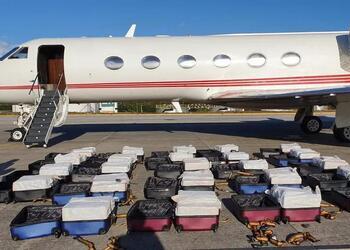Brazil’s cocaine and marijuana markets were not immune to the effects of the COVID-19 pandemic, but a recent report shows how drug traffickers quickly adapted to the new reality to keep their products flowing.
A July report by the United Nations Office on Drugs and Crime (UNODC) laid out how cocaine and marijuana trafficking in Brazil was affected by the impact of lockdown measures, the resulting economic downturn, state responses, and new criminal opportunities.
Here, InSight Crime breaks down the short- and long-term ramifications for drug flows through Brazil.
Marijuana Up, Cocaine Down
While marijuana seizures increased consistently throughout the pandemic, the overall quantity of cocaine seized nationwide temporarily decreased, albeit with regional variations.
From April 2020 to March 2021, marijuana seizures grew by 107 percent year-on-year, reaching almost 600 tons. In contrast, cocaine seizures dropped by about 20 percent. While a more significant number of individual seizures were reported, the average amount of cocaine involved in each stop plummeted, accounting for an overall quantitative drop.
There were likely several reasons for this. Firstly, the UNODC report noted that the flow of marijuana from Paraguay into Brazil “increased dramatically, likely as a consequence of reduced eradication activities and difficulties in cross-border collaboration.”
A parallel report carried out by the United Nations Development Programme (UNDP) showed that, while cocaine traffickers took to the skies to circumvent border closures, marijuana smugglers headed for remote areas. According to the UNDP, in the north of Brazil, the cities of Pacaraima and Boa Vista were entry points for Colombian marijuana, arriving by boat through Venezuelan waterways. And in the south, the state of Rio Grande do Sul saw the emergence of new trafficking clusters in 2020 that were not present in 2019, as marijuana from Paraguay was brought across.
SEE ALSO: Why Did Latin America’s Drug Trade Thrive During Covid-19?
Land Border Closures Led to More Drug Flights
Traditional methods of entry for cocaine into Brazil were disrupted early during the pandemic. The UNODC noted that, while cocaine production was high in Bolivia and Peru in 2019 and 2020, closures of land and water borders primarily through Paraguay meant that flights became the immediate fallback option.
“An increased flow of cocaine into the western border areas of Brazil shortly after the onset of COVID-19 seems to have been enabled…by traffickers increasingly resorting to clandestine flights to transport cocaine into Brazil,” read the report.
However, these flights seem to have been predominantly short-hop affairs, as the states where seizures increased the most were Mato Grosso do Sul and Paraná, which both border Paraguay.
This shift does not appear to have tipped the balance of power within Brazil’s drug trafficking landscape. The country’s leading gangs were best positioned to shift their routes and trafficking methods.
For example, the First Capital Command (Primeiro Comando da Capital – PCC) could afford to make the jump from cocaine trafficking via land routes to a greater reliance on clandestine aircraft. São Paulo prosecutor, Lincoln Gakiya, told the financial newspaper, Valor Econômico, that the PCC had bought “helicopters and small planes that can carry 400 kilos to 500 kilos of [cocaine]” from Bolivia and Paraguay.
As such, he explained, the closure of the Brazil-Paraguay border “did not cause them much problems.”
SEE ALSO: Aircraft Theft Across Latin America Continues to Fuel Drug Trade
Smaller Ports Take On Larger Roles
The UNODC report highlighted how, due to higher scrutiny at major seaports and greater demand for cocaine in Europe, Brazilian traffickers increased their use of smaller seaports.
“The diversification [of ports] had been observed before the pandemic but became particularly prominent during its course, and was especially visible in terms of the destination countries of cocaine trafficked from Brazilian ports,” read the report.
While the country’s largest port, Santos, near São Paulo, remained a mainstay for cocaine flows, other options to the north and south became increasingly popular. From 2019 to 2022, the southern port of Paranaguá in the state of Paraná, was commonly used to send cocaine to Europe by a group connected to the Calabrian Mafia in Italy. After its first-ever cocaine seizure in 2019, the port of Natal in the northeast of the country became a mainstay for sending the drug to the Netherlands. And the colossal drug operation of Sergio Roberto de Carvalho, one of Brazil’s largest-ever drug traffickers, used any port available in Brazil to move dozens of tons of cocaine to Europe.

